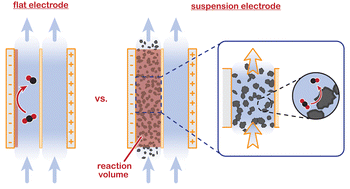Energy Adv., 2024, Advance Article
DOI: 10.1039/D3YA00611E, Paper
DOI: 10.1039/D3YA00611E, Paper
 Open Access
Open Access This article is licensed under a Creative Commons Attribution 3.0 Unported Licence.
This article is licensed under a Creative Commons Attribution 3.0 Unported Licence.Nathalie E. G. Ligthart, Gerard Prats Vergel, Johan T. Padding, David A. Vermaas
Poor mass transfer in aqueous electrochemical CO2 reduction limits the achievable current density toward desired products. We introduce flowable suspension electrodes to spread the current over a larger volume and alleviate mass transfer limitations.
To cite this article before page numbers are assigned, use the DOI form of citation above.
The content of this RSS Feed (c) The Royal Society of Chemistry
Poor mass transfer in aqueous electrochemical CO2 reduction limits the achievable current density toward desired products. We introduce flowable suspension electrodes to spread the current over a larger volume and alleviate mass transfer limitations.
To cite this article before page numbers are assigned, use the DOI form of citation above.
The content of this RSS Feed (c) The Royal Society of Chemistry

